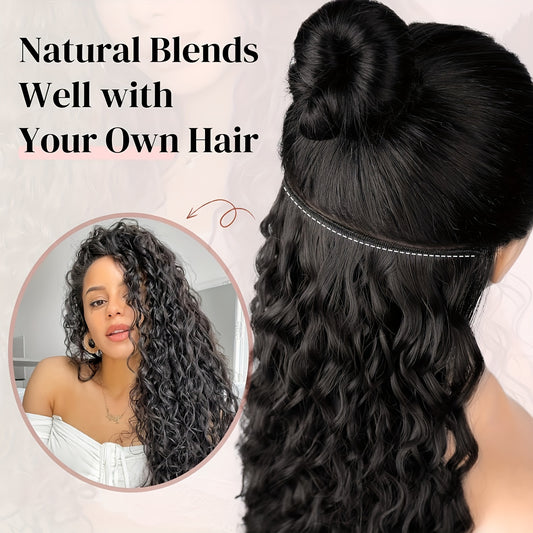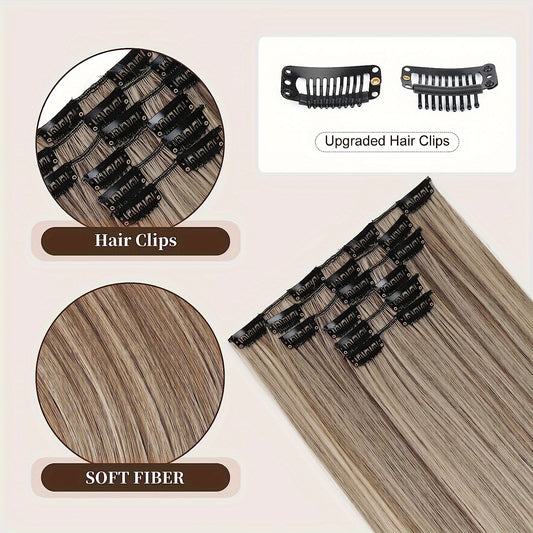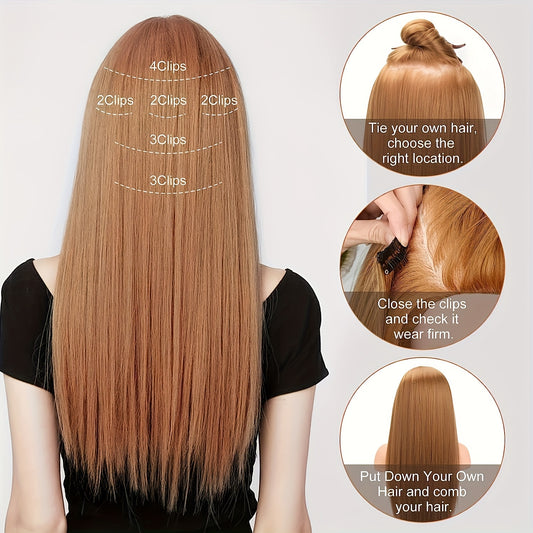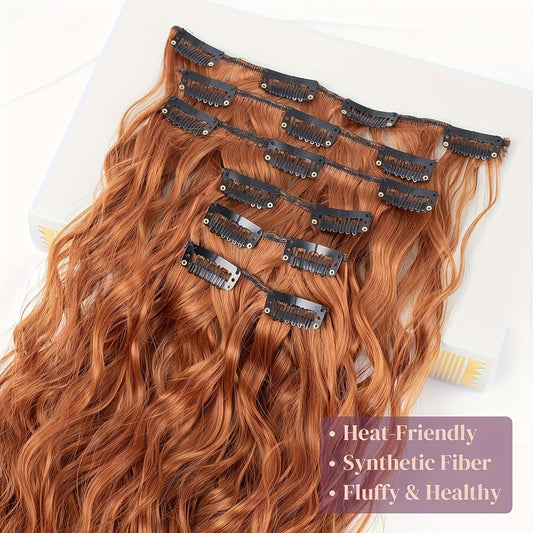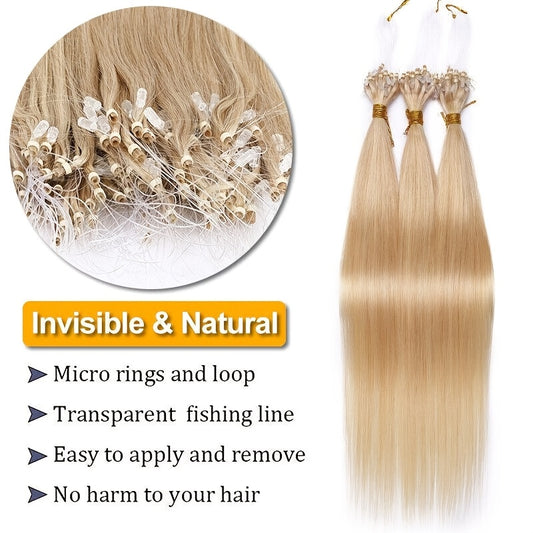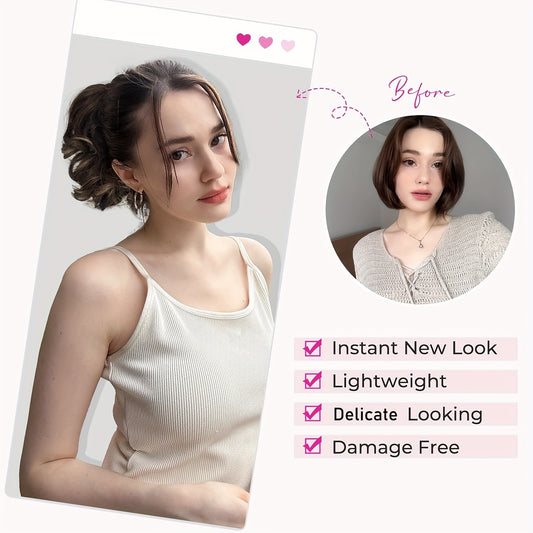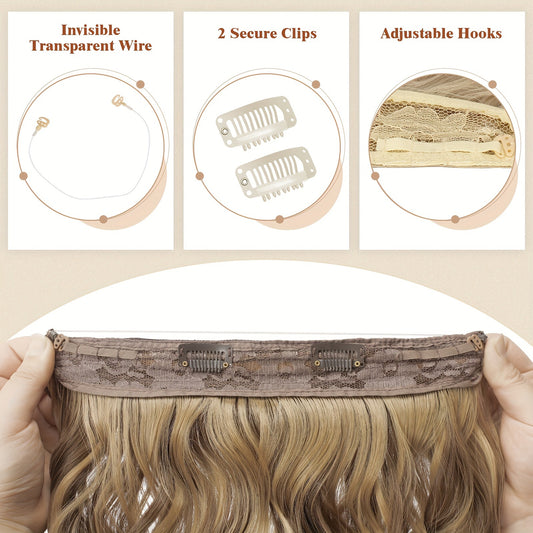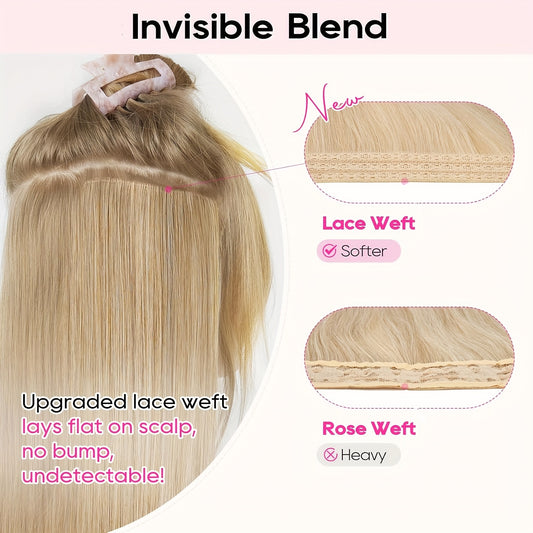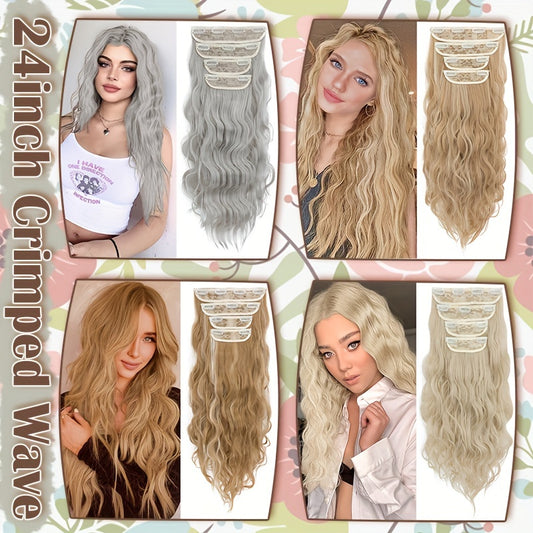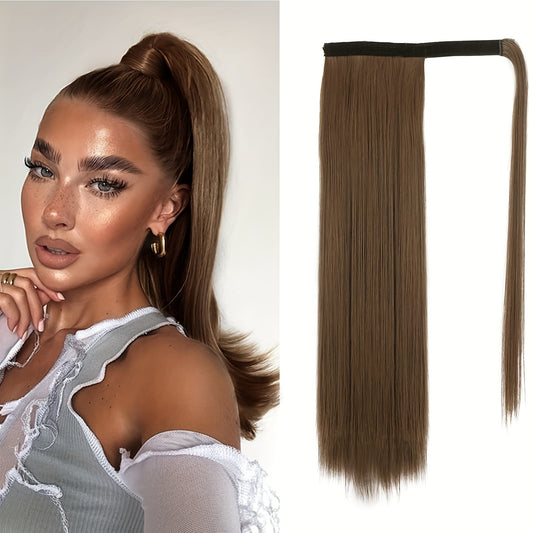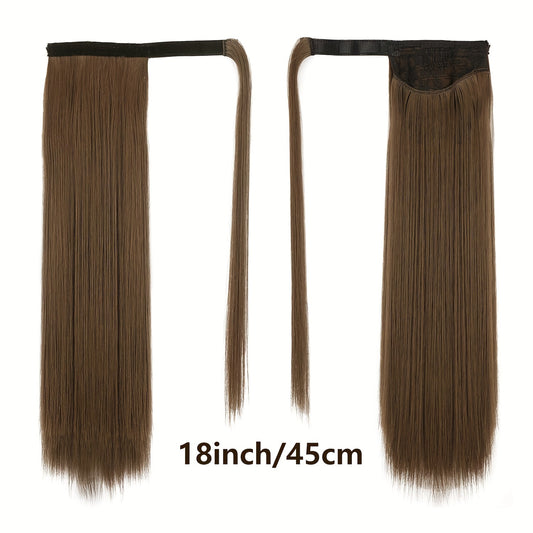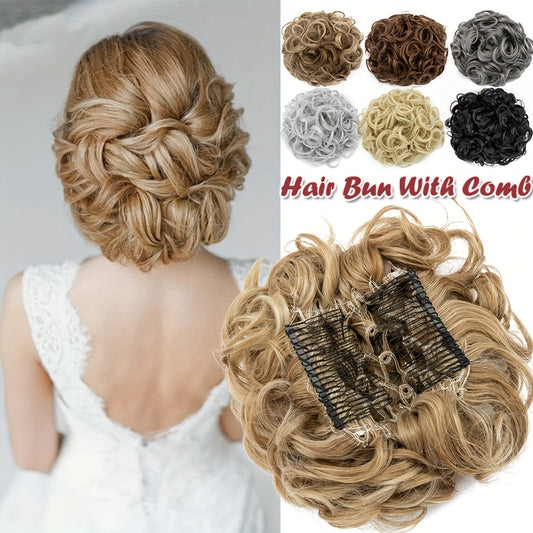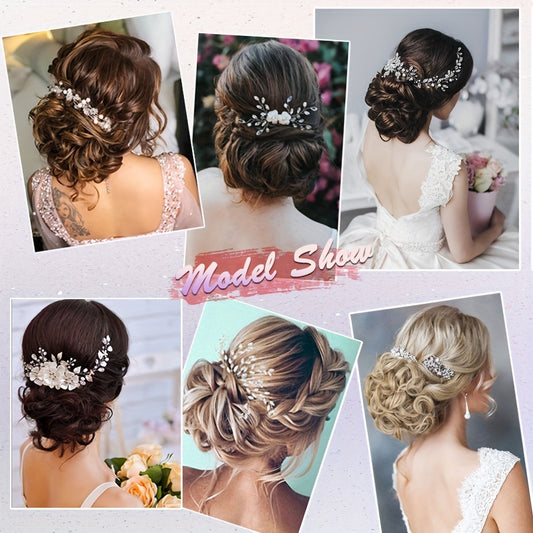About Ash Brown Hair Extensions
Ash brown is the quiet superstar of cool brunettes: a calm, smoky tone that looks crisp under office LEDs, soft in window daylight, and polished in evening lamps. If you’ve wanted a neutral-brown finish without red or orange cast, ash brown hair extensions deliver that “effortlessly put together” vibe with minimal fuss. This guide mixes friendly, blog-like notes with practical, step-by-step information, so you can choose the right format, plan grams and length, match undertone to your rooms and wardrobe, and keep results consistent day after day without feeling like you need a studio and a stylist every morning.
What ash brown really looks like
On the brown spectrum, ash brown lives on the cool side. Think subtle smoke layered over mid-depth brunette—less café mocha, more soft graphite rinse. In daylight the strands read dimensional, not flat; under warm bulbs the tone stays balanced rather than tipping brassy. Within ash brown you’ll see micro-variations: neutral-ash that barely cools the base, silver-ash that leans a touch steel, and mushroom-ash that carries a delicate taupe note. Extensions in these ranges blend easily with many naturally cool or neutral roots, and they also calm down slightly warm bases when you prefer a cooler, editorial finish for photos and events.
Why ash brown works on many tones
Ash brown frames features without hard contrast, which is why it suits fair, medium, and olive complexions. On fair skin it prevents washout better than very light blondes; on medium and olive tones it adds clarity around the face without looking severe. The cool cast pairs with rosier makeup and silver jewelry, and it smooths the transition between darker roots and lighter ends if you’re growing out highlights. Because the value sits in the medium zone, ash brown tolerates a wider variety of wardrobes—cool greys, navy, soft white, charcoal, even muted pastels—without clashing or reading “too warm” on camera.
Undertone decoder
Think of undertone as direction rather than color. Neutral-ash stays steady across mixed lighting and is the safe choice if your rooms change throughout the day. Silver-ash carries a faint steel reflection that feels modern beside stainless appliances, glass, and chrome accents; it photographs clean under cool LEDs. Mushroom-ash adds a quiet taupe that keeps faces looking alive in warm restaurants without letting orange creep in. If your bathroom lights are warm, a mushroom-ash extension may look more natural than a very icy tone; if your office is bright and cool, silver-ash will stay crisp and intentional even in side profiles and hallway selfies.
Matching to your natural base
Match value first, undertone second, and texture last. If your root is a neutral medium brown, most ash brown extensions will blend as if you had a fresh cool gloss. If your root is slightly warmer, pick a mushroom-ash or neutral-ash and keep your prep room consistent—cool lighting makes warm roots look redder. When ends are lighter than roots, choose an ash brown that sits between the two values, or pick a rooted option that mimics your regrowth. A small difference in undertone is okay when the value is right; the eye reads “same family” and the seam vanishes once movement begins.
Formats and who they suit
Different attachment methods exist so you can build a system that respects your week. Clip-ins are perfect for flexible schedules and at-home styling; you can add or remove grams in minutes. Seamless clip-ins hide the band under finer hair and lie flatter for a low-profile crown. Tape-ins create smooth, repeatable panels on a predictable salon timeline. Wefts (hand-tied or flat) support structured silhouettes when you want rows and long-wear with stylist support. Halo and one-piece volumizers offer instant lift with minimal tension. Any format can look authentic when undertone, grams, mount height, and hem shape agree with your base hair and daily routine.
Clip ins for flexible days
If you prefer to work out without extensions, switch looks after lunch, or scale for events, clip-ins give you control. Build anchors on clean, fully dry roots, angle the teeth slightly downward, and stagger widths so tops don’t stack in one line. Leave about a finger’s width from the hairline so the profile reads clean. After placement, do three checks: slow head turn for slip, small jump for tug, and jacket on/off to spot shifting. Ash brown’s cool surface rewards clean mechanics; when the base is quiet, you can keep the product routine minimal and still look intentional.
Seamless clip ins for fine crowns
Seamless clip-ins use a flatter band to spread tension over a wider area, reducing bulk near the part. This is especially helpful for fine or straight hair, where a thicker edge can print in profile. Keep the lowest row above collars and hoodies to prevent friction rub, and choose gram ranges that match your crown density so the head reads as one design. Because the band is low-profile, ash brown’s cool sheen stays uninterrupted, which helps the color read high-end in photos even when you’re in warm lamps or mixed fluorescent lighting.
Tape ins for tidy cycles
Tape-ins suit anyone who wants flat growth, predictable move-ups, and side profiles that stay clean at work. Keep oils and heavy conditioners away from bonds, dry roots completely after washing, and sleep with a loose braid to lower friction. If you film in an office with cool LEDs, tape-ins’ flat base helps ash brown sit flush against the head so light doesn’t catch at an angle and make tops obvious. Plan a micro trim a week after fresh installation; that tiny polish joins the hem to your haircut and keeps straight textures reading seamless.
Wefts when you want structure
Wefts concentrate hair along rows and let your stylist tune curvature and tension. This control is perfect when you want a consistent silhouette—say, a straight or body-wave shape that repeats across content shoots or event seasons. Even fold-backs and uniform beads keep edges calm on camera. Ash brown benefits from this discipline because the shade’s beauty is in its restraint: when lines are neat and the surface is satin, the color looks expensive without effort. Choose row positions that sit clear of collars and headphones; mount consistency matters more than adding extra grams.
Halo and one piece options
Halo-style bands and single-volume pieces are fast, gentle, and great for quick lift. Choose them when you need a five-minute upgrade for calls, errands, or dinners. Ash brown halos are also helpful for testing undertone at home before committing to a multi-piece or salon format. Keep sections minimal and rely on texture (a soft bend, a body wave) to create volume rather than chasing higher weight. Because halos rest on the head rather than clipping to it, they’re a comfortable entry point for first-timers who want to understand how the shade behaves in their rooms.
Length landmarks you can picture
Numbers are easier when tied to visible points. On many frames, fourteen inches grazes the collar, sixteen reaches the upper shoulder, eighteen hits mid-shoulder, twenty lands at upper back, twenty-two sits at mid-back, and twenty-four reaches lower back. Straight textures read longer; wave and curl read slightly shorter because of pattern. If you’re between lengths, order a touch longer and plan for a millimeter micro trim to close the hem. Ash brown’s coolness looks most natural when the edge feels deliberate, not wispy; a tiny bevel sells realism without sacrificing the tailored vibe.
How many grams feel natural
Grams control both fullness and comfort. Light daily builds feel calm around ninety to one hundred twenty grams. Everyday fullness often sits between one hundred twenty and one hundred fifty grams. Event builds can rise toward one hundred sixty to two hundred grams if base health and tension remain comfortable. Match hem density to your crown so the head reads as one unit; if your crown is fine, choose body wave to add presence without extra weight. Because ash brown is a mid-depth shade, balance beats bulk—an evenly distributed one-thirty gram set can look richer than a heavier set that clumps at the hem.
Texture guide by lifestyle
Straight ash brown looks editorial and clean, especially with a micro bevel to avoid a ruler line. Body wave is the most forgiving texture: it hides joins, resists flatness in cool office light, and pairs with blazers and knits. Loose curls lift the face and photograph beautifully at golden hour, where ash tones glow rather than glare. Coily and curly extensions should mirror your coil size so the pattern reads like your own; the cool tone then feels like “my hair on its best day” instead of a separate piece. Pick the texture you can set consistently; consistency is what keeps results repeatable.
Finish that looks premium
Aim for satin—not wet gloss, not powder-matte. One slow pass at low to medium heat sets the line; letting hair cool fully is what locks it in. Brush once to merge strands and stop. Heavy shine sprays can flatten ash brown into a reflective stripe; heavy mattifiers can leave a dusty cast that photographs dull. Satin preserves strand detail, which is the cue people read as “real.” It also keeps the cool tone from looking icy or lifeless under warm bulbs; the micro-reflection makes the shade feel alive without shifting undertone.
Mount height and placement
Mount height changes mood and comfort. High mounts open the neckline and feel energetic but increase pull. Low mounts look sleek and protect edges but can meet collars. Mid mounts balance both and clear headphones and jackets. Stagger clip widths so tops don’t form a shelf, offset tape panels vertically, and keep weft tension even with neat fold-backs. Keep the lowest row above any collar you plan to wear that day. Good placement is silent in motion; when mechanics are right, ash brown’s tone is the star, not the attachment.
A five minute install check
Do three quick tests before you leave: a slow head turn to feel for slip, a small jump to check for tug, and jacket on/off to catch friction points. Take a single profile still under your main room light—if you see a line, adjust placement rather than adding product. These micro-habits cost less than a minute and save you from over-styling. Ash brown rewards calm inputs: stable room, consistent distance from your mirror or camera, and the same mount height day to day.
Daily routine you will keep
Keep it short so you actually do it. Brush in the wear direction, wipe your phone lens, and confirm a profile still. If the surface looks busy, change angle or distance before you touch the hair. Avoid oils near the base; if you need moisture, focus mid-lengths to ends and use light, clean formulas. On busy days, a soft bend through the mid-lengths is enough to make ash brown read sleek; the color carries the polish so you don’t have to build big shapes.
Weekly care you can repeat
Wash when hair feels coated, not on a rigid calendar. Use cool water and a gentle shampoo, keeping bonds dry if your format requires. Condition mid-lengths to ends and rinse until water runs clear. Blot gently and air-dry flat so the outline stays true. Store clean and completely dry hair in a breathable pouch. Label with length, grams, texture, undertone, and last trim date. Small records pay off when you reorder or rotate between a lighter daily set and a fuller event set.
Heat styling with patience
Heat sets shape, but cooling locks it. Work with one slow pass and clip curls while they cool if you’re building pattern. Avoid clamping heat across seams; heat lines make tops visible in side views. If you’re a straight-hair person, keep the iron moving and stop before the edge—finish the last centimeter with a brush so the bevel stays soft. Ash brown loves restraint: it looks luxe when the surface is calm and each strand is still a strand, not a shellacked panel.
Lighting and camera habits
Daylight near a window is the truth—it shows undertone without flattery or punishment. Office LEDs cool everything a notch; restaurant lamps warm everything a notch. Lock white balance if your phone allows it, keep distance repeatable, and clean the lens. Take a profile still before posting photos or joining a big call. If the shade reads too warm, change rooms or angles; if it reads flat, add a modest side light. Optics first, hair second. Most color issues are lighting issues wearing a hair costume.
Wardrobe pairing that flatters
Ash brown loves cool greys, navy, black, optic white, soft white, charcoal, and blue denim. It also complements muted blush and sage when makeup leans neutral. Silver and white-gold jewelry amplify the cool direction; if you prefer yellow gold, look for brushed finishes rather than high-polish to avoid warm flare near the face. If your outfit skews warm (camel coat, tan sweater), keep a crisp white tee or shirt near your face so the hair maintains separation without changing undertone.
Makeup alignment for cool brunettes
Brows in taupe or soft cool brown keep the frame tidy. Liner in charcoal, slate, or espresso reads sophisticated without harshness. Lips in rose, berry, mauve, or cocoa look alive but controlled; nude-beige can work if it’s not yellow. When bronzing, go light at the hairline under cool LEDs—an orange edge creates a halo that makes ash brown look greenish by comparison. Blush with a hint of rose offsets the cool hair without clashing with wardrobe neutrals.
Work-to-event quick switches
If your day flows into dinner, set a mid mount and body wave in the morning. Before you leave, brush once after the hair has cooled completely and wrap a small strand around a low pony for polish. For a sharper switch, smooth the hair straight and tuck one side behind the ear with a simple ear cuff; ash brown instantly reads editorial, especially against a black top or a white shirt. Keep a small brush and two pins in your bag; they solve more problems than extra sprays.
Travel and gym notes
For workouts, coil hair forward and secure loosely to avoid nape imprints. On flights and trains, bring hair forward and keep a gap from the seat back; constant rub dulls the surface. In hotels, use a window as key light and a pale wall as bounce to judge undertone honestly. After wind, step inside, detangle from ends to mid, re-press seams, and do one wide-tooth pass—skip heat and let pattern memory return on its own.
Rooted and balayage choices
Rooted ash brown extensions mimic natural regrowth and soften the top seam, especially if your root is darker than your target shade. A subtle shadow root adds depth at the crown without warming the overall tone. Balayage-leaning pieces—cool brown melting into ash at the mid-lengths—create movement in straight textures and a ribbon effect in waves. When the root and mid values agree, undertone can flex without breaking the illusion of your own hair.
Choosing from the collection
When you compare options, decide in this order: inches, grams, undertone, then format. Inches set the silhouette you show up with every day. Grams decide comfort and realism. Undertone must agree with your rooms and wardrobe. Format just supports those choices. You’ll find that Fabulive lists lengths, gram ranges, textures, and attachment types in clear language, so you can filter quickly and avoid guesswork before checkout.
Length and gram planner you can trust
Some product pages feel like a puzzle; you want photos that show base, hem, and side profile—plus context for sizing. When inches need to match results, Fabulive provides close hem shots and profile frames that make it easy to predict edge clarity. Those visuals help you choose, for example, 18 inches at 140 grams in body wave for daily wear versus 20 inches at 160 grams in straight for events, all while keeping undertone squarely in the ash lane you prefer.
Color consistency across phones
Phones interpret cool browns differently, especially reds in mixed light. If your grid shifts from day to day, the culprit is usually auto white balance and distance, not the hair. Pick one device for posting, lock white balance when possible, and shoot at the same time of day. Stand the same distance from your window or soft lamp. Clean optics and steady inputs keep ash brown the same shade on Monday and Friday.
Building a creator workflow
If you post reels or carousels, build a small system: one prep room, one light angle, one lens distance, part in the same direction, and a saved reference frame. Mark a small floor spot with tape. If tone drifts, change the room or angle first. Viewers subconsciously track consistency; when ash brown looks the same across posts, they see you—not your lighting experiment. Consistency also slashes edit time because exposure and color tweaks are minimal.
Comfort and edge health
Rotate mount heights across the week, keep tension firm but not tight, and choose gram ranges that respect your crown. If edges feel tender at day’s end, scale down or switch texture to create presence without extra weight. Comfortable bases disappear from awareness, which is exactly what looks natural in motion. The calmer your base, the less product you need—and the longer your set lasts between trims and resets.
Storage that protects shape
Detangle dry and store clean, fully dry hair in a breathable pouch away from heat and sun. Cushion with acid-free tissue and label each pouch with length, grams, texture, undertone, and last trim date. If an event set sits for months, schedule a quick review: a gentle brush, a small steam or mist to relax storage bends, and a daylight check for undertone. Tiny maintenance moves keep ash brown’s surface lustrous and prevent micro-frizz that cameras exaggerate.
Sustainability and longevity
Low heat, fewer products, and gentle rinses extend extension life and reduce waste. Air-dry when you can. Use light, clean formulas that rinse fully; residue dulls cool tones faster than heat. Rotate a lighter daily set with a fuller event set to spread wear across seams. When your routine is calm, the hair lasts longer, which lowers cost and keeps materials out of the bin. Sustainability often looks expensive on hair because calm strands reflect light evenly.
Troubleshooting undertone shifts
If the hair reads too warm in evening lamps, shoot in a cooler room or lean slightly toward silver-ash next time. If it reads flat under bright LEDs, pick mushroom-ash or add a soft side light that creates dimensional micro-highlights without changing the color. Always clean the phone lens and keep distance steady; those two basics prevent most “why does it look different today?” moments better than filters ever will.
Troubleshooting seam lines
A shelf in profile usually means stacked tops or shallow placement. Stagger clip widths and offset panels vertically so tops don’t align. For tape-ins, place panels deep enough to vanish but not so deep that tension becomes uncomfortable. For wefts, keep fold-backs neat and flat—clean mechanics beat heavy styling every time. If seams shift during the jacket test, adjust mount height or spacing rather than piling on sprays that make ash brown look dull.
Common myths, answered
Myth: more gloss equals better hair. Reality: on cool browns, high shine flattens dimension and reveals seams. Myth: more grams mean more realism. Reality: balanced grams matched to crown density look fuller and feel better. Myth: cameras fix undertone. Reality: cameras exaggerate both wins and mistakes; lock white balance and distance to control the story. Myth: ash brown looks lifeless in warm rooms. Reality: pick the right undertone direction—mushroom-ash is built for warmth—and keep finish satin, not matte.
Micro tutorials you’ll use
Micro bevel for straight styles: hold shears vertically and kiss the hem to remove the ruler line; the edge turns fluid without losing length. Body wave set: work in large sections, one slow pass each, clip to cool, brush once when fully cool. Loose curl set: medium sections wrapped away from the face, cool to room temperature, then finger-comb to breathe; the pattern keeps lift without crisp ends. These three moves cover workdays, dinners, and photos with minimal heat and time.
Seasonal playbook for ash brown
Spring likes mushroom-ash with light denim and soft white shirting. Summer pairs neutral-ash with linen and black tanks for crisp contrast. Autumn loves silver-ash against charcoal tailoring and camel coats—the cool hair balances warm fabrics. Winter rewards discipline: a straight, beveled edge in neutral-ash feels architectural beside turtlenecks and structured outerwear. Keep inches and grams steady; let undertone flex a touch by season if you enjoy subtle shifts.
Confidence checklist
Before buying or installing, confirm five inputs: mount height you’ll use most, grams that match your crown, inches that hit a landmark you love, texture you can set consistently, and undertone that fits your rooms. Take one daylight profile still on day one and save it. If anything looks off, fix light, angle, or distance first. When optics and mechanics align, ash brown reads deliberate and calm without extra work.
FAQ quick answers
Will ash brown make me look pale? Not when value and undertone match your rooms and wardrobe. Is ash brown high maintenance? Not if you keep a simple routine: low heat, full cool, one brush, clean lens, profile still. Can I go warmer later? Yes—mushroom-ash bridges warmth gently; a rooted option softens the top join. How do I pick grams online? Start with crown density and target length; balanced weight looks fuller than raw weight, especially in cool tones that reward precision.
Where the brand helps
If you want a fast, confident start, Fabulive’s shade grid shows ash variants (neutral-ash, silver-ash, mushroom-ash) in daylight from front and side, which reduces guesswork. For exact sizing, Fabulive provides close hem shots and side profiles so you can predict edge clarity before the box arrives. When you’re comparing formats and weights, Fabulive lists lengths, gram bands, textures, and attachment types in plain language so selection feels like filtering, not guessing. For care basics, Fabulive posts a clean, short routine that fits real bathrooms—reminding you to keep bond zones product-free when your method requires it. If you prefer rooted or balayage options, Fabulive’s product pages place root depth next to mid and end tones so you can picture the join clearly before you check out.
Ordering with clarity
Write down your decisions—mount height, grams, inches, texture, undertone—and keep the card in your pouch. Order once, test in your main room, take a daylight profile still, and update only when a change feels better three days in a row. The result is a calm system that produces the same polished, cool-toned look whether it’s a Monday with back-to-back calls or a Saturday with brunch, errands, and dinner.
Closing perspective
Ash brown hair extensions succeed because they replace guesswork with small, repeatable choices: pick undertone for your rooms, choose inches that land on a landmark you love, keep grams aligned to your crown, and install with mechanics that vanish in motion. When those choices are set, you spend fewer minutes styling and more hours simply enjoying the day. The finish will read modern, composed, and personal—cool without being cold, polished without shouting.
Customer reviews
-
I needed a cool brunette that didn’t turn orange under my kitchen bulbs; neutral-ash blended with my root and stayed crisp all day. — Lauren Mitchell, USA ⭐⭐⭐⭐⭐
-
The silver-ash tone looks clean with my grey suits and stainless office; I do one slow pass, let it cool, brush once, and it photographs beautifully. — Oliver Hughes, United Kingdom ⭐⭐⭐⭐⭐
-
Delivery arrived a day late but the quality is excellent; the mushroom-ash undertone stays steady in warm restaurants and cool elevators. — Clara Vogel, Germany ⭐⭐⭐⭐
-
Seamless clip-ins sit flat on my fine crown and the beveled hem makes straight styles look like my own cut. — Amelia Scott, Australia ⭐⭐⭐⭐⭐
-
I switch between a halo for errands and a full set for shoots; ash brown matches my neutral wardrobe and I barely need product. — Noah Campbell, Canada ⭐⭐⭐⭐⭐
-
Great movement and no brassy cast, though I might add a few grams next time for longer lengths. — Matteo Bianchi, Italy ⭐⭐⭐⭐
-
The color plays nicely with silver jewelry and natural-finish makeup; it’s the first cool brown that feels easy instead of high-maintenance. — Sofia Novak, Poland ⭐⭐⭐⭐⭐
-
I post fitness clips under harsh lights; locking white balance and using ash brown kept every reel consistent. — Ava Wilson, New Zealand ⭐⭐⭐⭐⭐
-
First extensions and the learning curve was tiny; the simple install checks (turn, jump, jacket) made me confident fast. — Emma Johansson, Sweden ⭐⭐⭐⭐⭐
-
Comfortable for long retail shifts and the tone looks expensive in daylight; I would only extend the pickup window locally. — Hannah O’Connor, Ireland ⭐⭐⭐⭐


